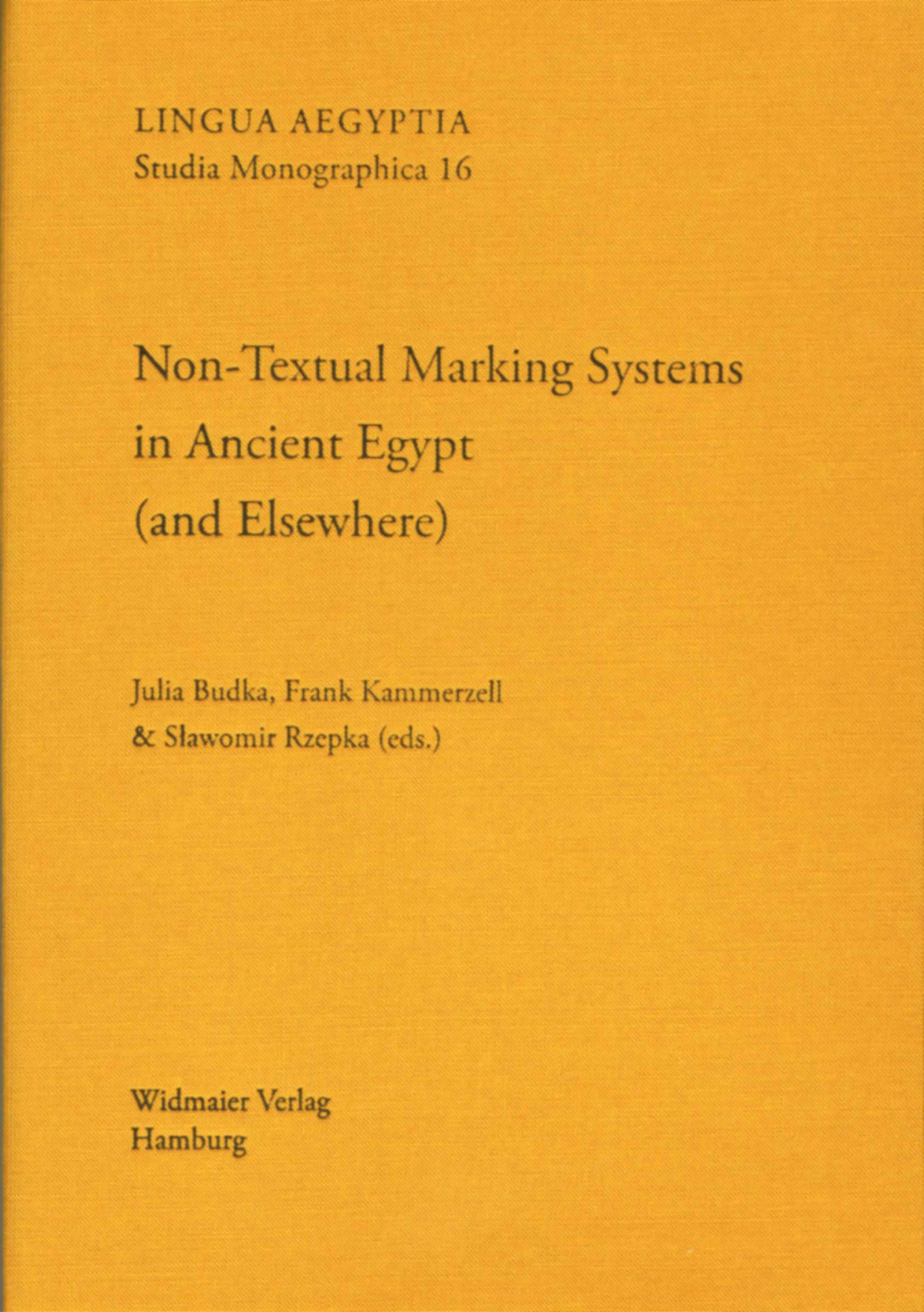The volume “Non-textual marking systems in Ancient Egypt (and Elsewhere)” is the outcome of a research linkage between Humboldt University Berlin and Warsaw University, funded by the Alexander von Humboldt Foundation. It aims to summarize the present state-of-the-art about non-textual marking systems in Pharaonic Egypt and to clear the way for a possible future analysis of the subject on a broader, cross-cultural level.
The focus is on Ancient Egyptian examples, but non-textual marking systems like pot marks, mason’s marks, brick marks and other identity marks are known from many cultures and periods from Prehistoric to modern times. The broad variability of use and function of these marking systems which occur irrespectively of whether or not the particular community has a script is illustrated by case studies and by a close comparison of material originating from different time periods and from various places in Egypt and elsewhere.
Description
Preface
ix-x
Methods & Semiotic
Petra Andrássy, Julia Budka & Frank Kammerzell,
Non-Textual Marking Systems in Ancient Egypt (and Elsewhere): An introduction
Non-Textual Marking Systems in Ancient Egypt (and Elsewhere): An introduction
1-8
Kyra van der Moezel,
Signification in Ancient Egyptian Builders’ Marks
Signification in Ancient Egyptian Builders’ Marks
9-30
Adam Łukaszewicz,
Arithmoi and Semeia
Arithmoi and Semeia
31-37
Architecture & Builders’ Marks
Kamil O. Kuraszkiewicz,
Non-textual Marking on a Construction Site
Non-textual Marking on a Construction Site
39-40
Kamil O. Kuraszkiewicz,
Marks on the Faience Tiles from the “Blue Chambers” of Netjerykhet’s Funerary Complex
Marks on the Faience Tiles from the “Blue Chambers” of Netjerykhet’s Funerary Complex
41-48
Dawid F. Wieczorek,
Building Dipinti in the Hatshepsut and Thutmose III Temples at Deir el-Bahari: Summarising four seasons of work (2006, 2008, 2009, 2011)
Building Dipinti in the Hatshepsut and Thutmose III Temples at Deir el-Bahari: Summarising four seasons of work (2006, 2008, 2009, 2011)
49-57
Myriam Seco Álvarez & Agustín Gamarra Campuzano,
Thutmosis III Temple of Millions of Years and the Mud Brick Marks: Conservation and first conclusions
Thutmosis III Temple of Millions of Years and the Mud Brick Marks: Conservation and first conclusions
59-67
Athena Van der Perre,
Quarry Marks of the Amarna Period: The limestone quarries of Dayr Abū Hinnis
Quarry Marks of the Amarna Period: The limestone quarries of Dayr Abū Hinnis
69-80
Maria Nilsson,
Non-textual Marking Systems at Gebel el-Silsila: From dynastic signifiers of identity to symbols of adoration
Non-textual Marking Systems at Gebel el-Silsila: From dynastic signifiers of identity to symbols of adoration
81-105
Deir el-Medina
Eva-Maria Engel,
Non-textual Marking Systems: The Case of Deir el-Medina
Non-textual Marking Systems: The Case of Deir el-Medina
107-108
Daniel Soliman,
Workmen’s Marks in Pre-Amarna Tombs at Deir el-Medina
Workmen’s Marks in Pre-Amarna Tombs at Deir el-Medina
109-132
Ben J. J. Haring,
Between Administrative Writing and Work Practice: Marks ostraca and the roster of day duties of the royal necropolis workmen in the New Kingdom
Between Administrative Writing and Work Practice: Marks ostraca and the roster of day duties of the royal necropolis workmen in the New Kingdom
133-142
Andreas Dorn,
Für jeden Arbeiter aus Deir el-Medine ein Namenszeichen?
Für jeden Arbeiter aus Deir el-Medine ein Namenszeichen?
143-158
Sławomir Rzepka,
“Funny signs” Graffiti vs. Textual Graffiti Contemporary or not?
“Funny signs” Graffiti vs. Textual Graffiti Contemporary or not?
159-183
Pot Marks
Julia Budka & Eva-Maria Engel,
Pot Marks from Ancient Egypt: The multiple function of marking ceramic vessels
Pot Marks from Ancient Egypt: The multiple function of marking ceramic vessels
185-186
Gaëlle Bréand,
Pot Marks on Bread Moulds in Settlement Context during Naqada III Period: A comparative view from Adaïma (Upper Egypt) and Tell el-Iswid South (Lower Egypt)
Pot Marks on Bread Moulds in Settlement Context during Naqada III Period: A comparative view from Adaïma (Upper Egypt) and Tell el-Iswid South (Lower Egypt)
187-213
Eva-Maria Engel,
The Early Dynastic Pot Mark Project
The Early Dynastic Pot Mark Project
215-228
Rita Hartmann,
Ein Corpus von Ritzmarken auf Weinkrügen aus dem Grab des Ninetjer in Saqqara
Ein Corpus von Ritzmarken auf Weinkrügen aus dem Grab des Ninetjer in Saqqara
229-243
Petra Andrássy,
Pot Marks in Textual Evidence?
Pot Marks in Textual Evidence?
245-253
Teodozja I. Rzeuska,
Noughts and Crosses Pot marks on the late Old Kingdom beer jars from West Saqqara
Noughts and Crosses Pot marks on the late Old Kingdom beer jars from West Saqqara
255-281
Julia Budka,
Marks on Egyptian Festival Pottery: The use of pot marks in the context of Osirian rituals at Umm el-Qaab, Abydos
Marks on Egyptian Festival Pottery: The use of pot marks in the context of Osirian rituals at Umm el-Qaab, Abydos
283-297
Julia Budka,
Pot Marks on New Kingdom Amphorae from the Oases: The case of Umm el-Qaab
Pot Marks on New Kingdom Amphorae from the Oases: The case of Umm el-Qaab
299-305
Gábor Schreiber,
Late Dynastic and Ptolemaic Pot Marks from the Thebaid
Late Dynastic and Ptolemaic Pot Marks from the Thebaid
307-320
